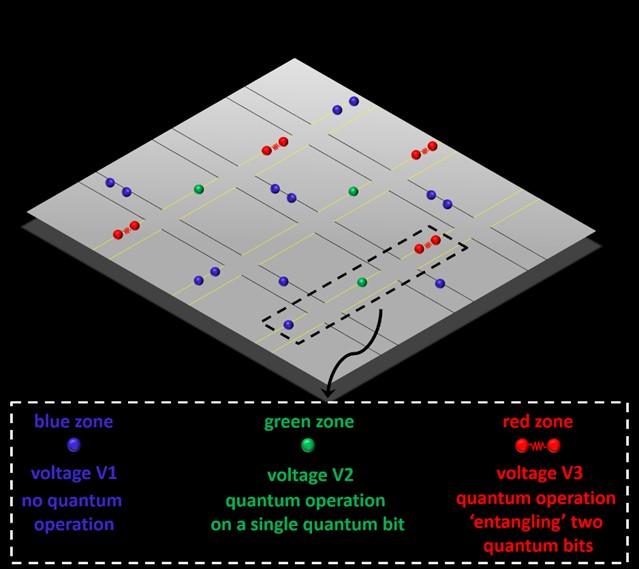Construction of practical quantum computers radically simplified

A trapped-ion quantum computer would consist of an array of X-junctions with quantum bits formed by individual ions that are trapped above the surface of the quantum chip (shown in grey). Individual quantum bits are manipulated simply by tuning voltages as easy as tuning a radio to different stations. Applying voltage V1 results in no quantum operation (blue zones), applying voltage V2 results in a quantum operation on a single quantum bit (green zones), applying voltage V3 results in a quantum operation 'entangling' two quantum bits (red zones). An arbitrary large quantum computer can be constructed based on this simple-to engineer approach. Credit: University of Sussex
Scientists at the University of Sussex have invented a ground-breaking new method that puts the construction of large-scale quantum computers within reach of current technology.
Quantum computers could solve certain problems – that would take the fastest supercomputer millions of years to calculate – in just a few milliseconds. They have the potential to create new materials and medicines, as well as solve long-standing scientific and financial problems.
Universal quantum computers can be built in principle – but the technology challenges are tremendous. The engineering required to build one is considered more difficult than manned space travel to Mars – until now.
Quantum computing on a small scale using trapped ions (charged atoms) is carried out by aligning individual laser beams onto individual ions with each ion forming a quantum bit. However, a large-scale quantum computer would need billions of quantum bits, therefore requiring billions of precisely aligned lasers, one for each ion.
Instead, scientists at Sussex have invented a simple method where voltages are applied to a quantum computer microchip (without having to align laser beams) – to the same effect.
Professor Winfried Hensinger and his team also succeeded in demonstrating the core building block of this new method with an impressively low error rate at their quantum computing facility at Sussex.
Professor Hensinger said: “This development is a game changer for quantum computing making it accessible for industrial and government use. We will construct a large-scale quantum computer at Sussex making full use of this exciting new technology.”
Quantum computers may revolutionise society in a similar way as the emergence of classical computers. Dr Seb Weidt, part of the Ion Quantum Technology Group said: “Developing this step-changing new technology has been a great adventure and it is absolutely amazing observing it actually work in the laboratory.”
###
Notes for editors
University of Sussex media relations contact: Julia Harris, 01273 678111 – press@sussex.ac.uk
The Ion Quantum Technology Group forms part of UK's National Quantum Technology Programme, a £270M investment by the UK Government to accelerate the translation of quantum technologies into the marketplace.
'Trapped-ion quantum logic with global radiation fields', by S. Weidt, J. Randall, S. C. Webster, K. Lake, A. E. Webb, I. Cohen, T. Navickas, B. Lekitsch, A. Retzker, and W. K. Hensinger is published in the journal Physical Review Letters (Phys. Rev. Lett. 117, 220501 (2016)).
A short film about Professor Hensinger's work can be found here: https:/
Prof. Hensinger heads the Ion Quantum Technology Group at the University of Sussex and he is Director of the Sussex Centre for Quantum Technologies. The group is part of the UK Quantum Technology Hub on Networked Quantum Information Technologies which is funded by the Engineering and Physical Sciences Research Council (EPSRC). As the main funding agency for engineering and physical sciences research, their vision is for the UK to be the best place in the world to Research, Discover and Innovate.
Media Contact
All latest news from the category: Information Technology
Here you can find a summary of innovations in the fields of information and data processing and up-to-date developments on IT equipment and hardware.
This area covers topics such as IT services, IT architectures, IT management and telecommunications.
Newest articles

A universal framework for spatial biology
SpatialData is a freely accessible tool to unify and integrate data from different omics technologies accounting for spatial information, which can provide holistic insights into health and disease. Biological processes…

How complex biological processes arise
A $20 million grant from the U.S. National Science Foundation (NSF) will support the establishment and operation of the National Synthesis Center for Emergence in the Molecular and Cellular Sciences (NCEMS) at…

Airborne single-photon lidar system achieves high-resolution 3D imaging
Compact, low-power system opens doors for photon-efficient drone and satellite-based environmental monitoring and mapping. Researchers have developed a compact and lightweight single-photon airborne lidar system that can acquire high-resolution 3D…





















